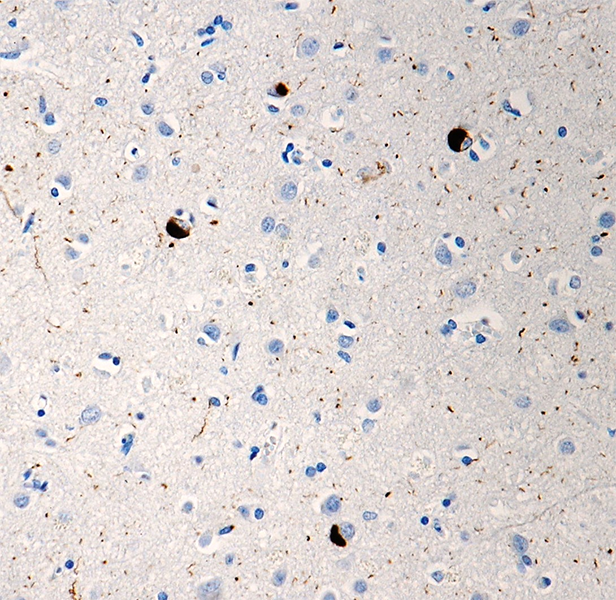- Clone
- Syn303 (See other available formats)
- Regulatory Status
- RUO
- Other Names
- Alpha-synuclein, synuclein alpha-140, NACP, PARK1, PARK4, PD1
- Previously
-
Covance Catalog# MMS-5085
- Isotype
- Mouse IgG1, κ
- Ave. Rating
- Submit a Review
- Product Citations
- publications

-

IHC staining of purified anti-α-Synuclein antibody (clone Syn303) on formalin-fixed paraffin-embedded human Parkinson's disease brain tissue. Following antigen retrieval using 70% formic acid for 20 minutes at room temperature, the tissue was incubated with 1 µg/ml of the primary antibody overnight at 4°C. BioLegend´s Ultra-Streptavidin (USA) HRP kit (Multi-Species, DAB, Cat. No. 929901) was used for detection followed by hematoxylin counterstaining, according to the protocol provided. The image was captured with a 40X objective.
| Cat # | Size | Price | Quantity Check Availability | Save | ||
|---|---|---|---|---|---|---|
| 824301 | 100 µL | 220€ | ||||
Alpha-synuclein is expressed principally in the central nervous system (brain) but is also expressed in low concentrations in a variety of tissues except liver. It is predominantly expressed in the neocortex, hippocampus, substantia nigra, thalamus, and cerebellum of the CNS. It is primarily a neuronal protein, but can also be found in the neuroglial cells. It is concentrated in presynaptic nerve terminals of neurons, as well as having reported nuclear and mitochondrial localization. Alpha-synuclein interacts with plasma membrane phospholipids. Alpha-synuclein in solution is considered to be an intrinsically disordered protein and thus lacks a stable secondary or tertiary structure. However, recent data suggests the presence of partial alpha helical as well as beta sheet structures as well as mostly structured tetrameric states in solution, the equilibrium of which may be altered by binding partners.
The human alpha-synuclein protein is made of 140 amino acids, encoded by the SNCA gene. The primary structure is divided in three distinct domains: (1-60) - an amphipathic N-terminal region dominated by four 11-residue repeats including the consensus sequence KTKEGV. This sequence has a structural alpha helix propensity similar to apolipoproteins-binding domains. (61-95) - a central hydrophobic region which includes the non-amyloid-β component (NAC) region, involved in protein aggregation. (96-140) - a highly acidic and proline-rich region. At least three isoforms of synuclein are produced through alternative splicing. The most common form of the protein, is the full 140 amino acid-long transcript. Other isoforms are alpha-synuclein-126, lacking residues 41-54; and alpha-synuclein-112, which lacks residues 103-130.
Alpha-synuclein may be involved in the regulation of dopamine release and transport and also may function to induce fibrillization of microtubule-associated protein tau. alpha-synuclein functions as a molecular chaperone in the formation of SNARE complexes. In particular, it can bind to phospholipids of the plasma membrane and to synaptobrevin-2 via its C-terminus domain to influence synaptic activity. Alpha-synuclein is essential for normal development of the cognitive functions and that it significantly interacts with tubulin. It also reduces neuronal responsiveness to various apoptotic stimuli, leading to decreased caspase-3 activation. Alpha Synuclein fibrils are major substituent of the intracellular Lewy bodies seen in Parkinson’s disease.
Product Details
- Verified Reactivity
- Human
- Antibody Type
- Monoclonal
- Host Species
- Mouse
- Formulation
- Phosphate-buffered solution.
- Preparation
- The antibody was purified by affinity chromatography.
- Concentration
- 1 mg/ml
- Storage & Handling
- This antibody should be handled aseptically as it is free of preservatives such as Sodium Azide. Store this antibody undiluted between 2°C and 8°C. Please note the storage condition for this antibody has been changed from -20°C to between 2°C and 8°C. You can also check the vial label or CoA to find the proper storage conditions.
- Application
-
IHC-P - Quality tested
- Recommended Usage
-
Each lot of this antibody is quality control tested by formalin-fixed paraffin-embedded immunohistochemical staining. For immunohistochemistry, a concentration range of 1.0 - 10.0 µg/ml is suggested. It is recommended that the reagent be titrated for optimal performance for each application.
- Application Notes
-
This antibody is effective in formalin-fixed paraffin-embedded immunohistochemical staining (IHC-P).
- Application References
-
- Beach, Thomas G, et. al. Evaluation of ?-synuclein immunohistochemical methods used by invited experts. Acta Neuropathol, 116(3): 277-288, September 2008.
- Uryu K, et al. 2003. Exp. Neurol. 184:214. (WB, IHC)
- Neumann M, et al. 2002. J. Clin. Invest. 110:1429. (IHC)
- Tsika E, et al. 2010. J. Neurosci. 30:3409. (WB)
- Fan Y, et al. 2006. Hum. Mol. Genet. 15:3002. (IHC)
- Tran HT, et al. 2014. Cell Rep. 7:2054. (IF, functional)
- Giasson BI, et al. 2002. Neuron 34:521. (EM)
- Luk KC, et al. 2009. Proc. Natl. Acad. Sci. USA 106:20051. (IF)
- Soper JH, et al. 2008. Mol. Biol. Cell. 19:1093. (IF, WB)
- Wilson CA, et al. 2004. J. Cell. Biol. 165:335. (IF, WB)
- Colla E, et al. 2012. J. Neurosci. 32:3301. (WB)
- Product Citations
-
- RRID
-
AB_2564879 (BioLegend Cat. No. 824301)
Antigen Details
- Biology Area
- Cell Biology, Neurodegeneration, Neuroscience, Protein Misfolding and Aggregation
- Molecular Family
- α-Synuclein
- Gene ID
- 6622 View all products for this Gene ID
- UniProt
- View information about alpha-Synuclein on UniProt.org
Related Pages & Pathways
Pages
Related FAQs
Other Formats
View All α-Synuclein Reagents Request Custom Conjugation| Description | Clone | Applications |
|---|---|---|
| Purified anti-α-Synuclein | Syn303 | IHC-P |
Customers Also Purchased
Compare Data Across All Formats
This data display is provided for general comparisons between formats.
Your actual data may vary due to variations in samples, target cells, instruments and their settings, staining conditions, and other factors.
If you need assistance with selecting the best format contact our expert technical support team.
-
Purified anti-α-Synuclein

IHC staining of purified anti-α-Synuclein antibody (clone Sy...

 Login / Register
Login / Register 
















Follow Us